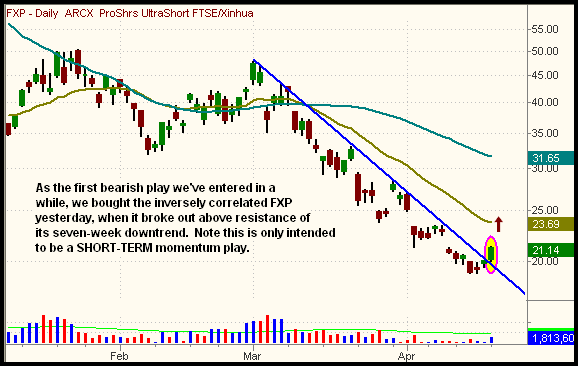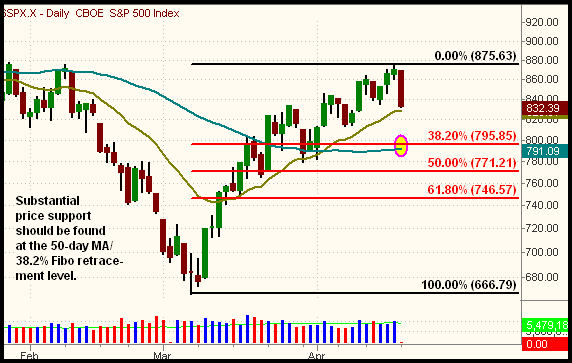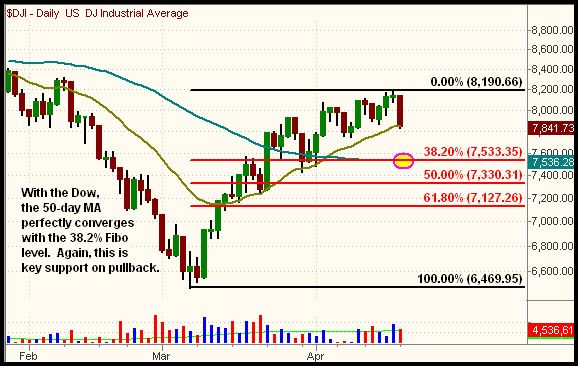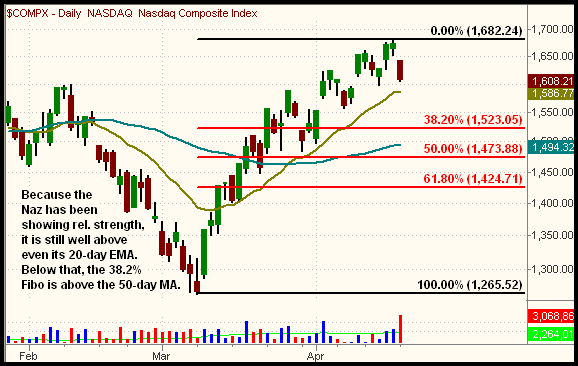|
The Wagner Daily ETF Report For April 21
Not surprisingly, resistance of the S&P 500's February highs triggered a broad-based sell-off yesterday, causing the major indices to register their largest losses in weeks. The Dow Jones Industrial Average tumbled 3.6%, the Nasdaq Composite 3.9%, and the S&P 500 4.3%. The small-cap Russell 2000 and S&P Midcap 400 indices plunged 5.6% and 5.4% respectively. All the main stock market indexes closed at their dead lows of the day, hinting at the possibility of continued selling pressure this morning.
Total volume in the NYSE eased 10%, enabling the S&P 500 to avert a "distribution day." Nasdaq volume rose 19% above the previous day's level, but it was deceivingly not really a session of institutional selling. If you factor out the 800 million share volume spike in Sun Microsystems (JAVA), sparked by Oracle's acquisition of the firm, turnover in the Nasdaq actually came in firmly below the previous day's level. It's always a positive sign when sharp declines in the stock market are not accompanied by increased turnover. Nevertheless, volume in both exchanges still exceeded 50-day average levels, so it wasn't exactly an extremely light volume sell-off either.
Yesterday, we bought one of the bearish, inversely correlated "UltraShort" ETFs we've had our eyes on. The setup and breakout entry is shown on the daily chart of UltraShort ProShares China (FXP) below:

When FXP rallied above the April 17 high yesterday morning, it broke out above a downtrend line that had been in place for the past seven weeks. We bought that breakout above the downtrend line, anticipating a quick upward thrust in FXP. Because the main stock market indexes are still in short and intermediate-term uptrends, our plan with this trade is merely to capture short-term momentum of the trend reversal. Intended time horizon of this trade is less than two weeks. Since FXP is inversely correlated to the direction of iShares China (FXI), buying FXP is similar to selling short FXI for a short-term trade.
Given that yesterday's decline showed the most selling urgency of any "down" day since the seven-week rally began, it's quite possible a short-term correction may be underway. As such, let's take a look at how far the major indices may retrace before finding significant support that could enable them to resume their uptrends. Knowing the approximate target areas for broad-based retracements enables one to be prepared with new pullback entries in strongly trending ETFs. First, let's look at the daily chart of the benchmark S&P 500 Index:

The 20-day exponential moving average (EMA), just below yesterday's closing price, could provide a bit of price support in yesterday's session. However, a drop of more than 0.5% would cause the S&P 500 to break below its 20-day EMA. Given that the S&P 500 zoomed nearly 30% from its March low to April high, without a significant correction along the way, it's realistic to expect yesterday's pullback to last more than a day. If the S&P 500 breaks support of its 20-day EMA, the next stop could be the 50-day moving average (the teal line), presently at the 795 area. With Fibonacci retracement lines applied to the chart above, notice that the first major retracement level of 38.2% roughly converges with the 50-day MA. When a 38.2%, 50%, or 61.8% Fibonacci retracement level converges with a key moving average, such as the 20 or 50-day, support at that level becomes even more significant. As such, it's safe to say that a pullback to roughly the 791 area would represent a low-risk area to enter new long positions, even in broad-based ETFs such as the S&P 500 SPDR (SPY) or Ultra ProShares S&P 500 (SSO). Below is a daily chart of the blue-chip Dow Jones Industrial Average:

In terms of areas of support, the daily chart of the Dow is very similar to that of the S&P 500. The index closed right at the 20-day EMA, and its 38.2% Fibonacci retracement converges with its 50-day MA (at the 7,536 area). The main notable difference between the two indexes is that the Dow fell short of reaching its February highs before heading back down. This is because the Dow has shown relative weakness to the S&P 500 throughout the recent rally. Finally, check out the daily chart of the Nasdaq Composite:

Since the Nasdaq has shown the most relative strength of the major indices on the way up, it's still firmly above even its 20-day EMA. Below that, the 38.2% Fibonacci retracement should catch a pullback in the Nasdaq before it has a chance to test its 50-day MA. On the pullback, if looking for a new buy entry into the broad market, the Nasdaq ETFs probably offer a better chance of profitability than the S&P and Dow ETFs, based on the relative strength the index has been showing.
In yesterday's commentary, we said, "If you've been absent from the long side of the market, it's understandable to feel left behind by the market's recent strength. However, after six straight weeks of gains in the major indices, this is not the time to be chasing stocks and ETFs. . .With the S&P 500 now kissing a major area of horizontal price resistance, traders have the perfect excuse to take some chips off the table, thereby triggering a pullback in the market. . .There is always the possibility the S&P 500 will ignore resistance of its late January/early February highs, and continue higher for another week. But strictly from a technical point of view, a price retracement or correction by time (consolidation) is likely." Indeed, patient traders who've avoided chasing overextended stocks and ETFs in recent days were rewarded yesterday.
The key now, of course, is to be prepared to catch the market's next leg up, after the market exhibits signs the short-term correction is finished. It's impossible to know exactly how deep the retracement will go, but the targets outlined above are quite realistic. New buy entries based on those support levels carry a much better risk-reward ratio than any new trades that could have been taken over the past week. Still, we must not forget one crucial fact: all the major indices remain in long-term downtrends; only the short and intermediate-term trends have changed. Therefore, we continue to play it relatively conservatively on the long side of the market.
Open ETF positions:
Long - FXP, OIH
Short - (none)
Deron Wagner is the Founder and Head Trader of both Morpheus Capital LP, a U.S. hedge fund, and Morpheus Trading Group, a trader education firm launched in 2001 that provides daily technical analysis of the leading ETFs and stocks. For a free trial to the full version of The Wagner Daily or to learn about Wagner's other services, visit MorpheusTrading.com or send an e-mail to deron@morpheustrading.com.
|